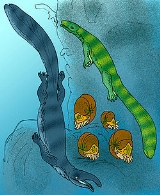
Thalattosauridae
Encyclopedia
Thalattosauridae is a family
of extinct marine diapsid
reptile
s which lived along the Pacific coast of Late Triassic North America
. Specimens of two genera, Thalattosaurus and Nectosaurus, have been found in California
.
In life, the typical thalattosaur would have resembled a large lizard up to 7 feet in length, half of which being the elongated, flattened tail. Despite resembling lizards, the thalattosaurs' relationships with other diapsids is obscure, with most experts pigeonholing them somewhere between ichthyosaur
s and archosaur
s. Their closest relative is Askeptosaurus
, which was also a marine diapsid from the Triassic.
There are several recognized genera
of thalattosaurs. The largerThalattosaurus
(which contains two species, T. alexandrae and T. shastensis) fed on shellfish, and the smaller Nectosaurus
halinus ate fish. In 1993, Nicholls and Brinkman described Paralonectes merriami and Agkistrognathus campbelli from fossils found at Wapiti Lake, British Columbia
, extending the known range of the family to what is now Canada
.
Family (biology)
In biological classification, family is* a taxonomic rank. Other well-known ranks are life, domain, kingdom, phylum, class, order, genus, and species, with family fitting between order and genus. As for the other well-known ranks, there is the option of an immediately lower rank, indicated by the...
of extinct marine diapsid
Diapsid
Diapsids are a group of reptiles that developed two holes in each side of their skulls, about 300 million years ago during the late Carboniferous period. Living diapsids are extremely diverse, and include all crocodiles, lizards, snakes, and tuatara...
reptile
Reptile
Reptiles are members of a class of air-breathing, ectothermic vertebrates which are characterized by laying shelled eggs , and having skin covered in scales and/or scutes. They are tetrapods, either having four limbs or being descended from four-limbed ancestors...
s which lived along the Pacific coast of Late Triassic North America
North America
North America is a continent wholly within the Northern Hemisphere and almost wholly within the Western Hemisphere. It is also considered a northern subcontinent of the Americas...
. Specimens of two genera, Thalattosaurus and Nectosaurus, have been found in California
California
California is a state located on the West Coast of the United States. It is by far the most populous U.S. state, and the third-largest by land area...
.
In life, the typical thalattosaur would have resembled a large lizard up to 7 feet in length, half of which being the elongated, flattened tail. Despite resembling lizards, the thalattosaurs
Ichthyosaur
Ichthyosaurs were giant marine reptiles that resembled fish and dolphins...
s and archosaur
Archosaur
Archosaurs are a group of diapsid amniotes whose living representatives consist of modern birds and crocodilians. This group also includes all extinct non-avian dinosaurs, many extinct crocodilian relatives, and pterosaurs. Archosauria, the archosaur clade, is a crown group that includes the most...
s. Their closest relative is Askeptosaurus
Askeptosaurus
Askeptosaurus is an extinct genus of aquatic reptile related to the thalattosaurian group. Their remains have been found in Italy and Switzerland.Askeptosaurus was a very thin, elongated creature, that probably swam like an eel...
, which was also a marine diapsid from the Triassic.
There are several recognized genera
Genus
In biology, a genus is a low-level taxonomic rank used in the biological classification of living and fossil organisms, which is an example of definition by genus and differentia...
of thalattosaurs. The largerThalattosaurus
Thalattosaurus
Thalattosaurus is an extinct genus of marine reptile in the family Thalattosauridae that lived during the Triassic period. It includes two known species.Thalattosaurus was a shellfish-eating reptile around 2 meters in length....
(which contains two species, T. alexandrae and T. shastensis) fed on shellfish, and the smaller Nectosaurus
Nectosaurus
Nectosaurus is a genus of marine diapsid reptile which lived during the Late Triassic of what is now California. The type species is N. halinus, described by John C. Merriam in 1905. A 2002 analysis of Nectosaurus classifies it as a thalattosaurian, one of a group of marine reptiles which lived...
halinus ate fish. In 1993, Nicholls and Brinkman described Paralonectes merriami and Agkistrognathus campbelli from fossils found at Wapiti Lake, British Columbia
British Columbia
British Columbia is the westernmost of Canada's provinces and is known for its natural beauty, as reflected in its Latin motto, Splendor sine occasu . Its name was chosen by Queen Victoria in 1858...
, extending the known range of the family to what is now Canada
Canada
Canada is a North American country consisting of ten provinces and three territories. Located in the northern part of the continent, it extends from the Atlantic Ocean in the east to the Pacific Ocean in the west, and northward into the Arctic Ocean...
.

